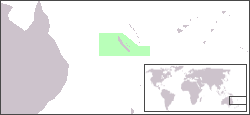Geography of New Caledonia

Map of New Caledonia
|
|
 |
|
| Geography | |
|---|---|
| Location | Pacific Ocean |
| Coordinates | 21°21′03″S 165°25′56″E / 21.350781°S 165.432129°E |
| Area | 18,575 km2 (7,172 sq mi) |
| Area rank | 53rd |
| Length | 350 km (217 mi) |
| Width | 70 km (43 mi) |
| Highest elevation | 1,628 m (5,341 ft) |
| Highest point | Mont Panié |
| Administration | |
|
France
|
|
| Overseas departments and territories of France | New Caledonia |
| Largest settlement | Nouméa (pop. 91,386) |
| Demographics | |
| Population | 208,709 (2004) |
| Pop. density | 12.75 /km2 (33.02 /sq mi) |
| Ethnic groups | Melanesian 44.6%, European 34.5%, Wallisian 9.1%, Tahitian 2.7%, Indonesian 2.6%, Vietnamese 1.4%, Ni-Vanuatu 1.2%, other (Filipino) 3.9% |
The geography of New Caledonia (Nouvelle-Calédonie), an overseas collectivity of France located in the subregion of Melanesia, makes the continental island group unique in the southwest Pacific. Among other things, the island chain has played a role in preserving unique biological lineages from the Mesozoic. It served as a waystation in the expansion of the predecessors of the Polynesians, the Lapita culture. Under the Free French it was a vital naval base for Allied Forces during the War in the Pacific.
The archipelago is located east of Australia, north of New Zealand, south of the Equator, and just west of Fiji and Vanuatu. New Caledonia comprises a main island, Grande Terre, the Loyalty Islands, and several smaller islands. Approximately half the size of Taiwan, the group has a land area of 18,575.5 square kilometres (7,172.0 square miles). The islands have a coastline of 2,254 km (1,401 mi). New Caledonia claims an exclusive fishing zone to a distance of 200 nmi or 370 km or 230 mi and a territorial sea of 12 nmi (22 km; 14 mi) from shore.
New Caledonia is one of the northernmost parts of an almost entirely (93%) submerged continent called Zealandia which rifted away from Antarctica between 130 and 85 million years ago (mya), and from Australia 85–60 mya. (Most of the elongated triangular continental mass of Zealandia is a subsurface plateau. New Zealand is a mountainous above-water promontory in its center, and New Caledonia is a promontory ridge on the continent's northern edge.) New Caledonia itself drifted away from Australia 66 mya, and subsequently drifted in a north-easterly direction, reaching its present position about 50 mya. Given its long stability and isolation, New Caledonia serves as a unique island refugium — a sort of biological 'ark' — hosting a unique ecosystem and preserving Gondwanan plant and animal lineages no longer found elsewhere.
...
Wikipedia
